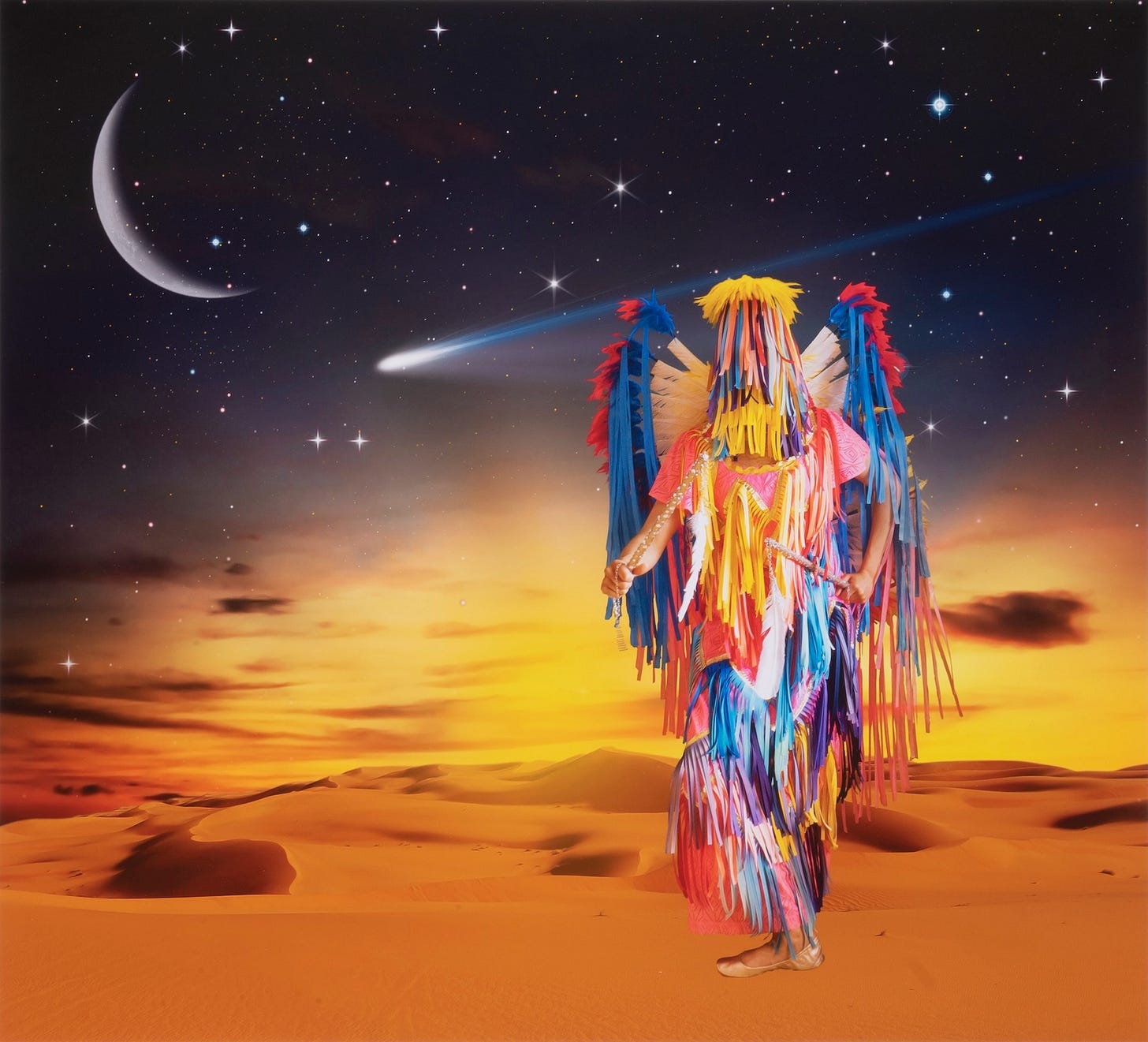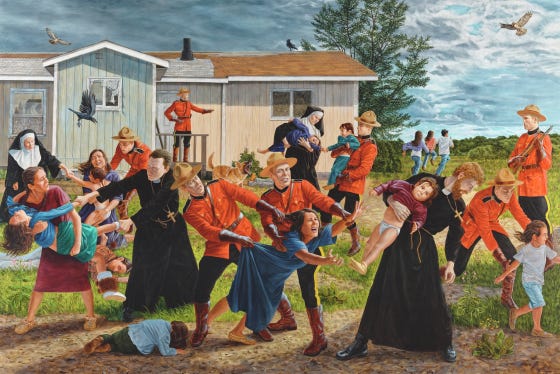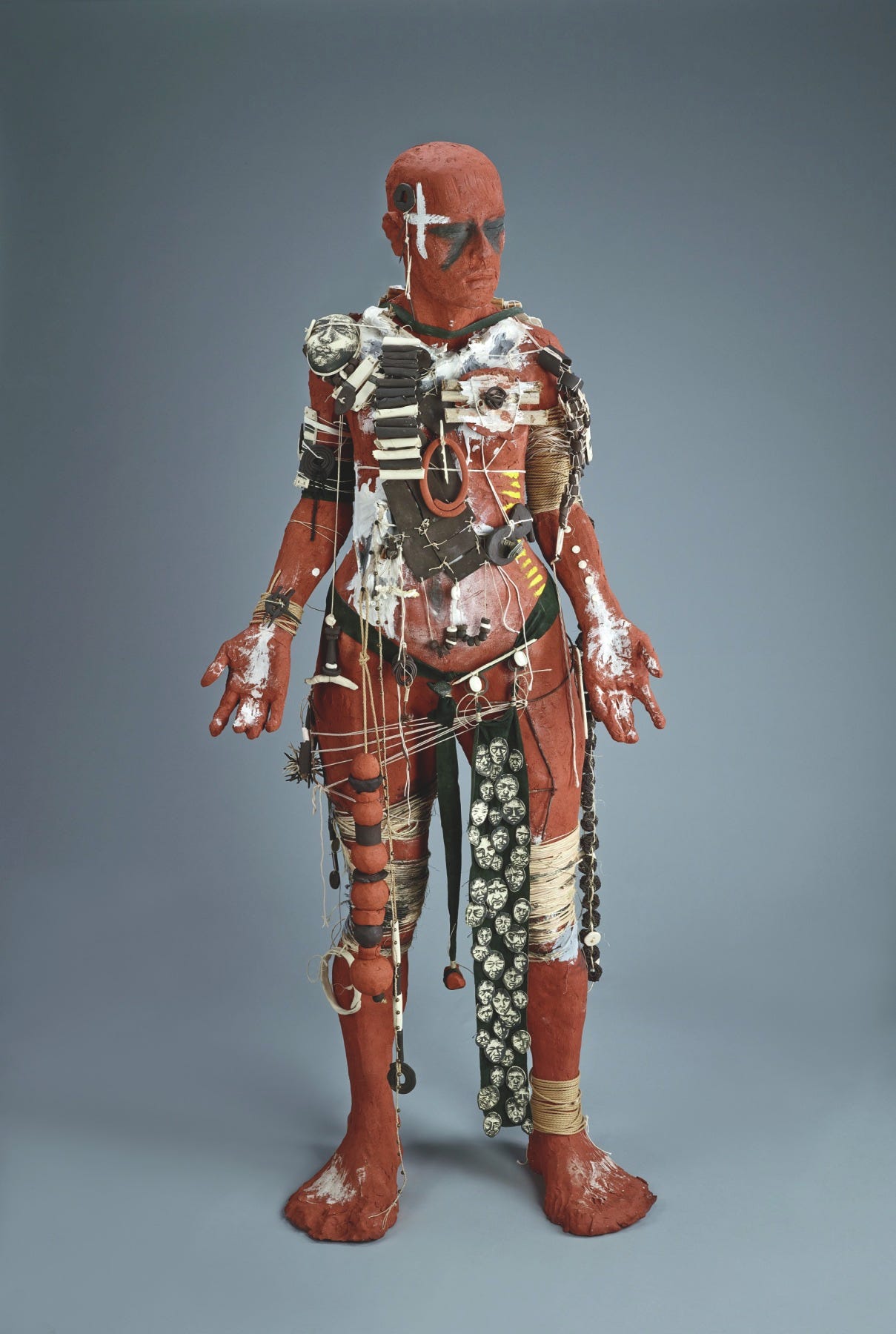Indigenous Art as a Healing Response to Centuries of Colonization
It is inspiring to witness how Native American artists are expressing with ever-increasing freedom their inherent creativity.
Indigenous art is inspiring for its imaginative artistry and themes. Yet even more significant is that much of the art addresses the mistreatment and colonization of Indigenous people in our country and beyond. Indeed, the work is often a response to the fraught heritage of Native Americans over the last several centuries.
Stirs Up the Dust, 2011. Courtesy of Wendy Red Star. Autry Museum of the American West
Maltreatment of Indigenous people in America hearkens back to its foundations, and to the 19th-century belief in Manifest Destiny. This declaration asserted that white settlers and their governments had the divine right to overtake the country, and the larger continent of North America. The creed was employed to defend the United States’ and Canada’s (and several other countries) forced removal of Native people from their homes and from the land that they had occupied for twenty thousand years.
A statement by President Biden on October 25, 2024 asserted that government-run Indian boarding schools were one of the “most horrific chapters in American history that most Americans don’t even know about.” These actions resulted in personal trauma, as well as loss of native language and culture for millions of Native children.
Artists and museums in the U.S. and Canada have been wrestling with the social fallout from these draconian measures for decades. While other marginalized groups assert their presence through activism and art, Indigenous people have a unique legacy as the first inhabitants of our country, possessing a powerful identity and a many-centuries-long cohesive cultural output. Their contemporary descendants draw on their achievements to produce important artwork while confronting the stereotyped 20th-century depictions of “Indians” as objects in film, television, and the visual arts.
Wendy Red Star (Apsaalooke (Crow)). Alaxchiiaahush / Many War Achievements / Plenty Coups. 2014. Baltimore Museum of Art
Wendy Red Star, (Apsaalooké, Crow), a 2024 MacArthur Genius Grant winner, recasts historical images of Indigenous people into healing visual statements. Among her most well-known work is “1880 Crow Peace Delegation” series (2014), composed of 10 reproduced, manipulated photos of 19th century Native American men from the National Archives. Red Star first reproduced the photos of the men wearing decorative Indian regalia — forced on them by ambitious photographers — and then inscribed on them red inked narratives, describing what she presumes the men were thinking. One narrative reads, “I am ashamed your self-pity has stolen your courage, robbed you of your spirit and self-respect. Stop mourning the old days. They are gone with the buffalo.”
Red Star’s series has been exhibited in museums throughout this country, including The Baltimore Art Museum with the 2024 exhibition, “Preoccupied, Indigenizing the Museum” exposed and demystified colonial influences on Indigenous people from the 19th century to the present. In the exhibition catalog, Leila Grothe, the museum’s Associate Curator of Contemporary Art, wrote, “Projects like ‘Preoccupied’ may help broaden awareness of the vital contributions to our collective past, present, and future generated by individuals influenced by their personal Native experience.” Dale Turner, Curator of Indigenous Art at the Brooklyn Museum, added, “By curating historic and contemporary Native art, I hope to both honor my ancestors and offer a Native vision of the future.” She also wrote, “It challenges all museums to interrogate their colonial roots and make space for new ways of thinking, learning, and being.”
Kent Monkman (Fisher River Band Cree), “The Scream,” 2017, acrylic on canvas. Courtesy of the Denver Art Museum. © Kent Monkman
The Denver Art Museum, which has been collecting and displaying Indigenous art for nearly a century, is also featured in the “Preoccupied” catalog with an essay by John Lukavic, the museum’s Curator of Native Arts. He wrote, “The Denver Art Museum’s Commitment to Indigenous Communities opens with a formal land acknowledgment and recognizes how we are complicit in harming originating communities. The statement also posits that we must change and recognizes how central Indigenous people and arts are to our institution.”
Artwork by Canadian Kent Monkman (Fisher River Cree Nation) has been prominently displayed at the Denver Art Museum. His 11-foot-wide acrylic painting "The Scream” (2017) dramatically illustrates the Royal Canadian Mounted Police and priests and nuns from 100 years ago, abducting Indigenous children from their parents to send them to the Indian boarding schools that President Biden referred to. The painting is a powerful statement about the diaspora of Native Americans through colonization, trauma, and loss.
Another dramatic artwork at DAM is Rose Simpson’s (Santa Clara Pueblo) mixed media “Warrior” (2012), a life-size sculpture of a woman expressing energy, self-actualization and empowerment to deal with life’s challenges. The “warrior” title and the work’s message recall the Jungian “Wild Woman Archetype,” asserting independence, free-spiritedness, and the ability to “vanquish the predator, taking from it what is useful and leaving the rest,” according to analyst and writer, Clarissa Pinkola Estés.
Rose Simpson, (Santa Clara Pueblo), “Warrior,” 2012, clay and mixed media. Courtesy of the Denver Art Museum. © Rose B. Simpson
At the Autry Museum of the American West in Los Angeles, “Future Imaginaries: Indigenous Art, Fashion, Technology,” through June 2026, addresses Native art with an adventurous approach. The massive exhibition, according to the catalogue, “explores the role of Indigenous Futurisms, a wide-ranging and fast-growing movement in Indigenous literature, visual art, and other media that draws on worlds past to imagine worlds to come.” Time travel and cosmic phenomena have been employed as tactics in modern Indigenous art for decades as a means of interrogating colonization, environmental degradation, and stereotypes.
The exhibition includes examples of Indigenous couture, featuring clothing blending ancestral Native fashion with contemporary modes to express power, presence and style. Some designs were created by victims of sexual assault, as Native women are “Almost 40 percent more likely to be assaulted, raped, or murdered than their non-Native peers,” according to the catalogue.
Red Star again appears here with her installation, “Stirs Up the Dust” (2011), of a female mannequin clad in a powwow dance costume. Adorned with candy-colored streamers, an elaborate bustle and a conceptual headpiece, the artist places her cosmic dancer in a Martian landscape, projecting the artwork into the future and outer space.
Virgil Ortiz (Cochiti Pueblo), “Recon Watchmen,” 2022, ceramic, video, and vinyl (artist's proposal for his installation at the Autry Museum)
“ReVOlt 1680/2180: Sirens & Sikas” by Cochiti Pueblo artist Virgil Ortiz is the most dramatic of several videos on display. The sci-fi style film depicts the 1680 Native Pueblo Revolt, which was a response to Spanish colonizers ravaging the landscape and decimating the Pueblo population. The historic uprising expelled the colonizers and freed the Natives for 12 years until 1692, when the Spanish returned and stole the lands again. The video, recasting that demoralizing history, engages time travelers from 2180 to return to 1680 in order to aid and record their ancestors’ culture. Accompanied by Native chanting combined with electronic music, the video brings us into a futuristic world of healing and creativity.
Apocalypse is “an opportunity for innovation and for reflection and renewal. In a sense ... Indigenous people have been at a privilege when it comes to any kind of hardship because we’ve already survived,” explains Rose Simpson. Her soulful self-reflection is manifested in her own work and in the creations of many other Indigenous artists. With the evolution of the Red Power and American Indian Movements over the last half-century, it is inspiring to witness how Native artists are expressing with ever-increasing freedom their inherent creativity.







